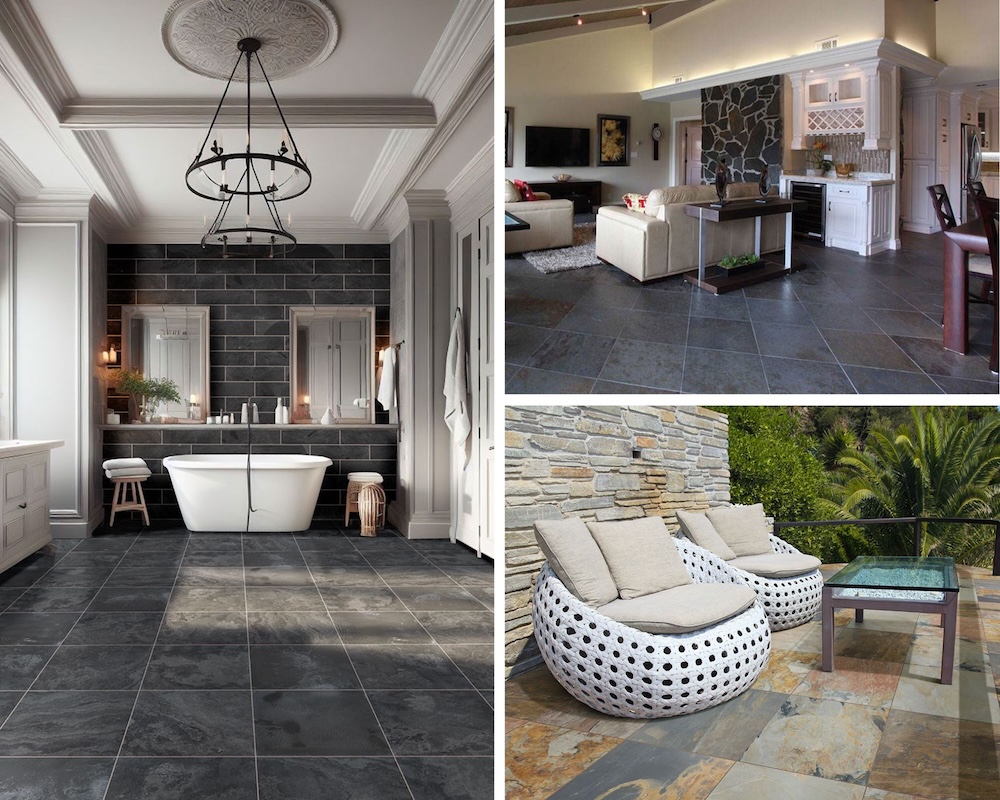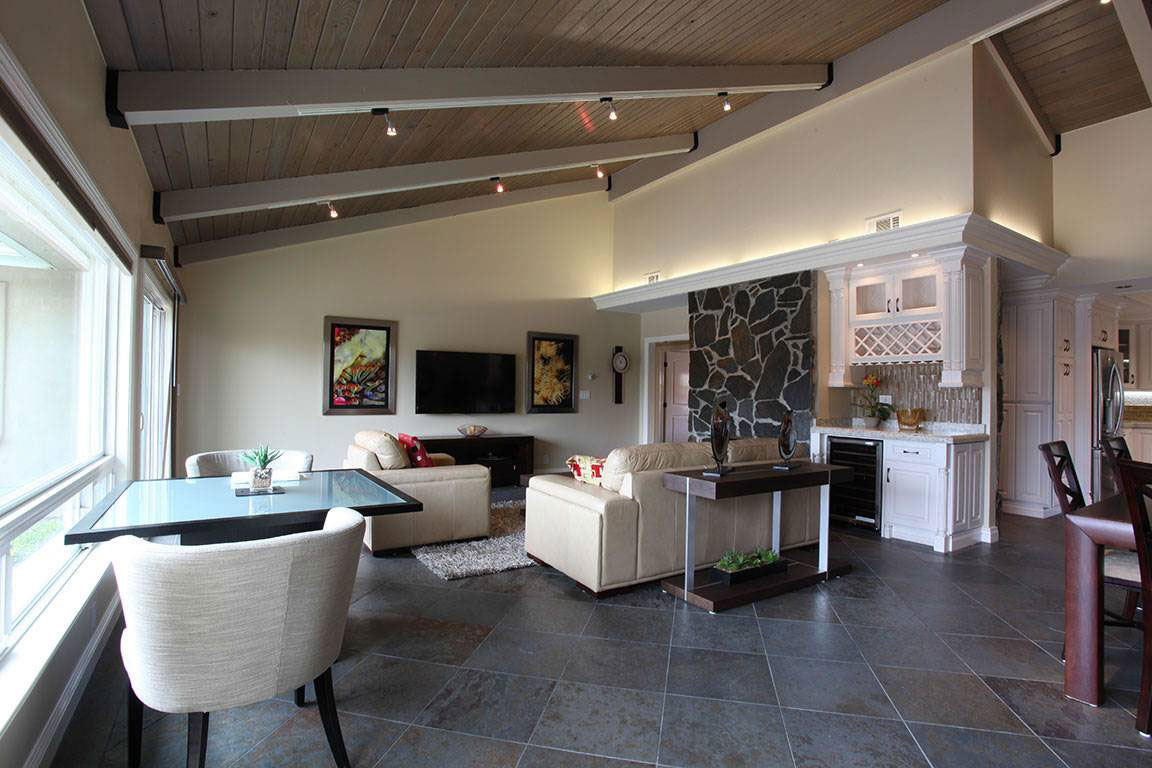Make Slate Floors Shine: How To Get A Permanent Wet Finish
May 30, 2025
There are many different types of natural stone tiles for bathroom floors, but for rich color and beautiful texture, slate tile flooring is hard to beat. This popular choice features striking rusty-red, brown, and gray hues and complements both modern and rustic home designs. One of the main benefits of choosing a natural stone like slate is the variety of finishes available, from honed to brushed. Yet, believe it or not, slate tile offers another finishing option. With the application of a sealer, your natural stone can achieve a permanent wet look that enhances its natural beauty! Here, we detail the differences in types of sealers and explain how you can create a wet look for your slate floor.
Enhancing Sealer on Slate
If you want to brighten up your slate floor tile and avoid that dull, chalky look, a sealer can work wonders. An enhancing sealer, for example, can give your tile flooring a lovely shine and a fresh, wet appearance. You’ll find both solvent- and water-based options, but many find solvent-based enhancers easier to apply and more effective in absorbing into the stone, making your project a bit simpler and more beautiful.
The ideal time to apply a solvent-based sealer is approximately 72 hours after your flooring tiles have been installed. For older slate tile, make sure to give it a good cleaning before sealing.
Start by testing the enhancer on a spare tile. If satisfied with the results, continue with the rest of your flooring. Apply it directly to the stone and spread it evenly with a towel. After the sealer has absorbed into the slate for about 10 minutes, reapply as necessary. Note: Solvent-based sealers have higher VOC levels than water-based ones. To reduce odor, ensure good ventilation or wear a respirator if needed. The smell will dissipate over the next few hours after completing the project.
Glossy Sealer on Slate
For a glossy, polished appearance on your slate tiles, use a topical glossy sealer. You can choose between solvent-based or water-based options; however, solvent-based sealers tend to be more durable and last longer. While a glossy sealer provides better protection against moisture and stains compared to an enhancing sealer, it may also make scratches more visible on the shiny surface.
Apply the sealer by spreading a light coat across one section of flooring at a time. Avoid touching the tiles until the sealant is fully dry, which usually takes around four hours. You might opt for a second coat to achieve your desired level of shine. To maintain the appearance, it’s advisable to strip and reapply the glossy sealer every couple of years.
Impregnating Sealer on Slate
If you love the natural beauty of slate, consider using a clear impregnating sealer to keep its original color and texture intact. A water-based sealer works best for this, as it soaks into the stone and then fades away, leaving behind a lovely, natural appearance.
When applying the clear impregnating sealer, you can follow the same steps as you would with an enhancing sealer. Keep in mind, while the sealer is wet, your tile flooring will look darker, but once it dries, it will return to its beautiful, natural look.
As you can see, there’s more than one way to love slate flooring, and with a bit of elbow grease, you’re sure to achieve the look that suits your aesthetic perfectly. To learn more about where to buy slate flooring, chat with us online, visit an MSI showroom, or contact your nearest MSI authorized dealer.
FAQs about Sealing Slate Floors
Q: What is a "permanent wet look" for slate floors? A: A permanent wet look for slate floors refers to enhancing the natural rich colors and textures of the slate to appear as if it's consistently damp, bringing out its rusty-red, brown, and gray hues, which can be achieved through the application of a specific type of sealer.
Q: What are the main types of sealers used to get a wet look on slate floors? A: The article primarily discusses two types of sealers for a wet look: * Enhancing Sealer: Provides a lovely shine and a fresh, wet appearance, brightening the tile. * Glossy Sealer: Creates a highly polished, glossy appearance, offering significant protection.
Q: Should I use a solvent-based or water-based enhancing sealer? A: While both are available, the article suggests that many find solvent-based enhancers easier to apply and more effective at absorbing into the stone, leading to a simpler and more beautiful result. However, solvent-based sealers have higher VOC levels.
Q: When is the best time to apply a solvent-based enhancing sealer after new slate flooring is installed? A: The ideal time to apply a solvent-based sealer is approximately 72 hours after your new slate flooring tiles have been installed.
Q: Do I need to clean old slate tile before applying a sealer? A: Yes, for older slate tile, it's crucial to give it a thorough cleaning before sealing to ensure proper absorption and an optimal finish.
Q: How do I apply an enhancing sealer to my slate floor? A: After testing on a spare tile, apply the sealer directly to the stone and spread it evenly with a towel. Reapply as necessary after it has absorbed for about 10 minutes.
Q: Are there any concerns with applying solvent-based sealers? A: Yes, solvent-based sealers have higher VOC (Volatile Organic Compound) levels and can produce a strong odor. It's recommended to ensure good ventilation or wear a respirator if needed. The smell typically dissipates within a few hours.
Q: What is the main difference between a glossy sealer and an enhancing sealer? A: An enhancing sealer provides a "wet appearance" and brightens the stone, while a glossy sealer provides a high-shine, polished appearance and typically offers better protection against moisture and stains.
Q: How do I apply a glossy sealer to my slate floor, and how long does it take to dry? A: Apply a light coat across one section of flooring at a time. Avoid touching the tiles until the sealant is fully dry, which usually takes around four hours. A second coat can be applied for desired shine.
Q: How often do I need to reapply a glossy sealer to maintain the finish? A: To maintain the appearance of a glossy sealer, it's advisable to strip and reapply it every couple of years.
Q: Does a clear impregnating sealer give a wet look to slate? A: No, a clear impregnating sealer is used to keep the slate's original color and texture intact, providing a natural appearance once dry, rather than a wet look.
 Autumn Slate
Autumn Slate Montauk Black Slate
Montauk Black Slate San Rio Rustic Slate
San Rio Rustic Slate